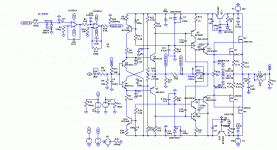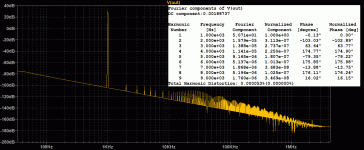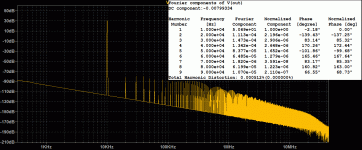Pizzicato, a 250W low distortion CFA amplifier
It is a CFA power amp Diamond input with gain, Cascode input & VAS, driver, Power Laterals MOSFETS.
250W under 8 Ohms, 500W under 4 Ohms.
Very low simulated Distortion (Cordel models) : 0.000020% @ 1KHz, 0.000508% @ 10K. (Simulated @250W)
It was published here to be a collaborative project.
The attachments in this post is the raw project, a development start, just to propose a frame: You will see the changes and improvements in the definitive version.
[edit] The definitive version is in post #428
Pizzicato #428
250W under 8 Ohms, 500W under 4 Ohms.
Bandwidth, without low pass input filter: 10MHz (-3dB)*
Phase margin: 60°, gain margin: 13dB.*
Slew-rate*: 240V/µs (*to be adjusted on the bench)
Loop Gain >100dB up to >1KHz.
0.000002% à 1W 8Ohms 1000Hz
0.000010% @100W
0.000020% à250W
DC coupled with optional added error correction, original Servo, very fast protection(25µs) against DC, internal failure, clipping, oscillation etc that will protect both amp and speakers.
The protection is in Post 378.
Pizzicato, #378
This version (V) is treated like a VFA, but keep the "expansive" behavior of a CFA and high slew rate. May-be a more traditional CFA version (C), with a flat loop up to 10KHZ will come to can figure out if any listening difference. And get an idea of the thresholds of audibility of distortion, if loop gains makes a difference on the amp's character and listening experience etc.
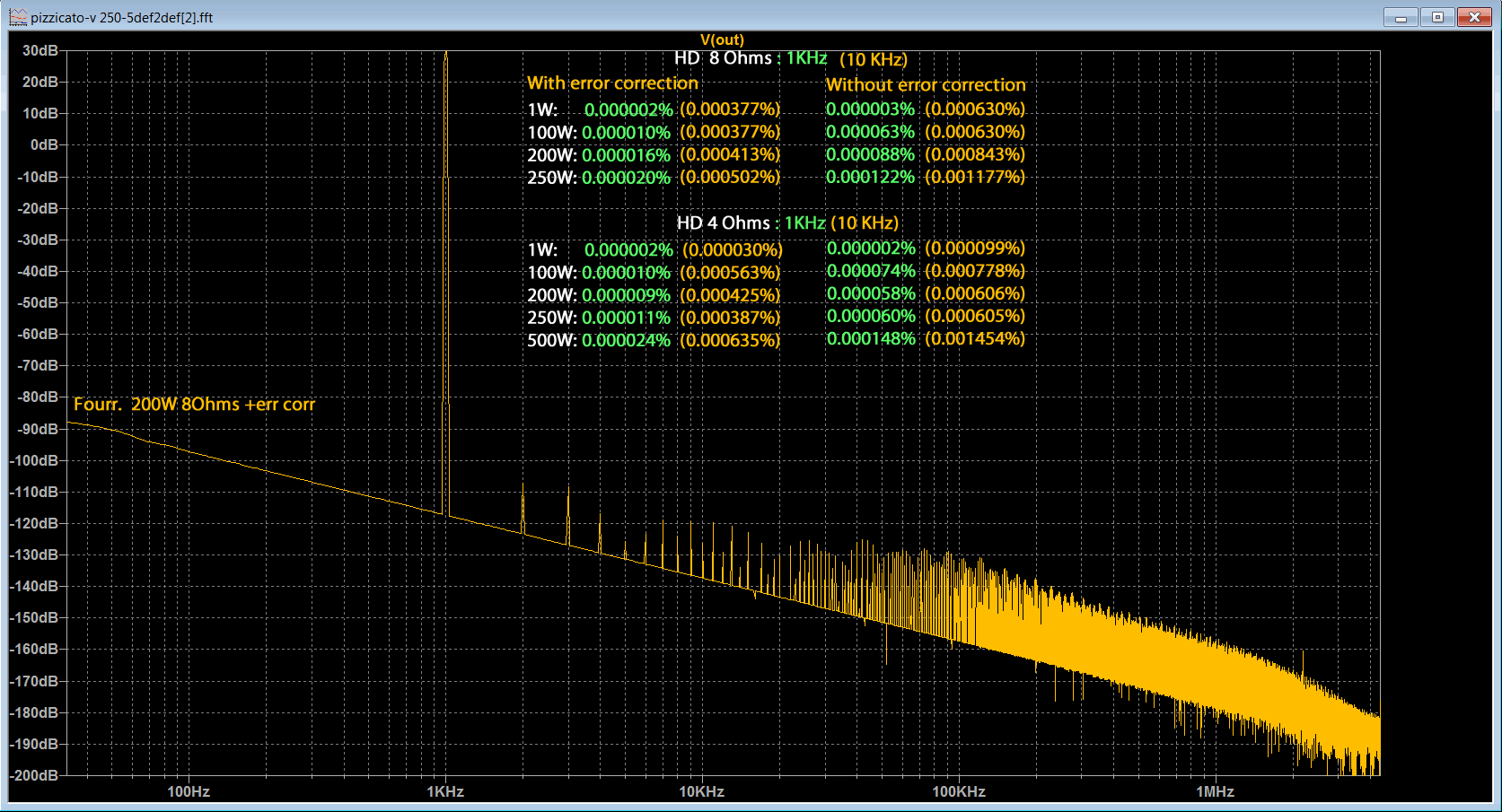
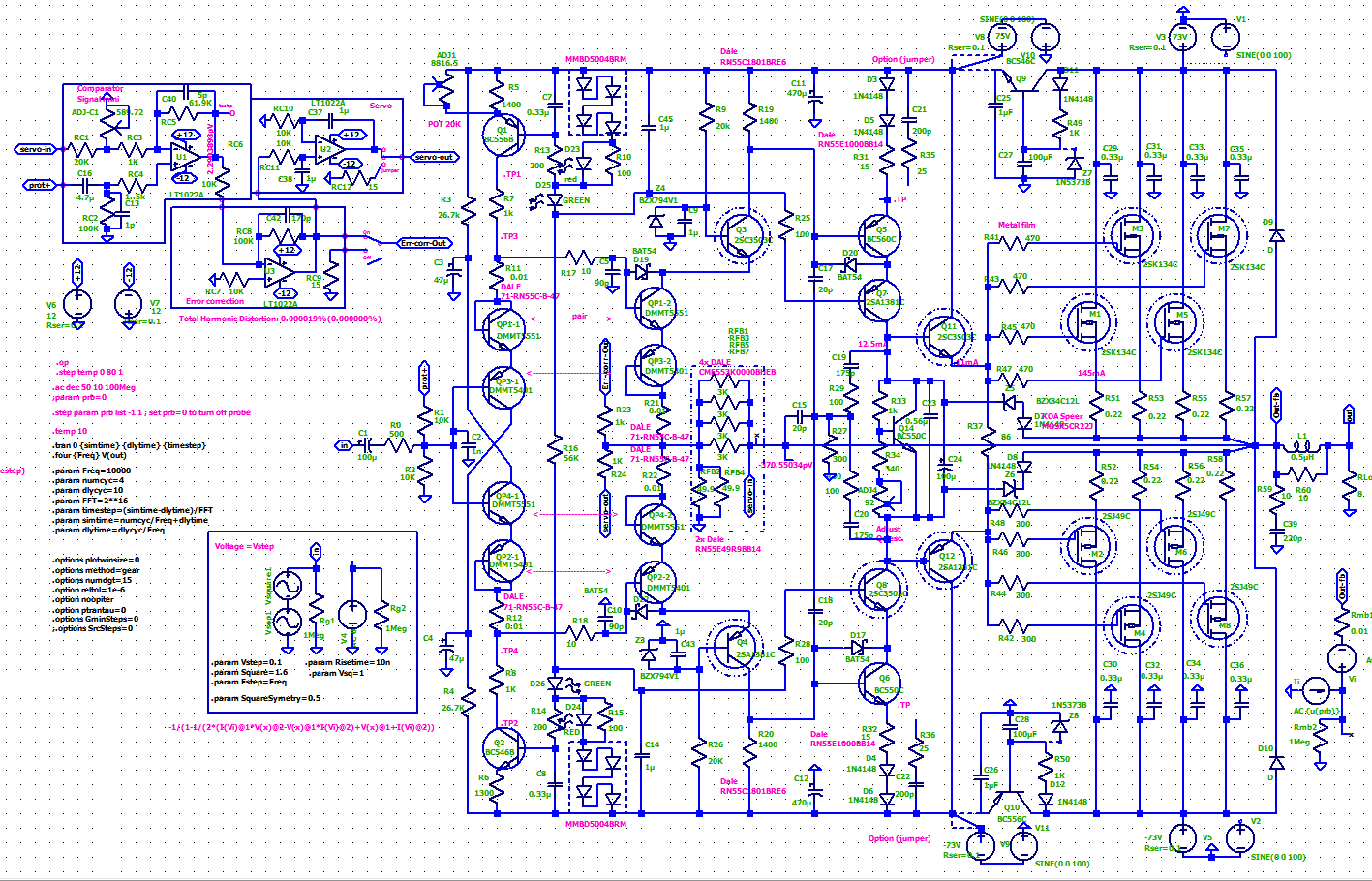
It is a CFA power amp Diamond input with gain, Cascode input & VAS, driver, Power Laterals MOSFETS.
250W under 8 Ohms, 500W under 4 Ohms.
Very low simulated Distortion (Cordel models) : 0.000020% @ 1KHz, 0.000508% @ 10K. (Simulated @250W)
It was published here to be a collaborative project.
The attachments in this post is the raw project, a development start, just to propose a frame: You will see the changes and improvements in the definitive version.
[edit] The definitive version is in post #428
Pizzicato #428
250W under 8 Ohms, 500W under 4 Ohms.
Bandwidth, without low pass input filter: 10MHz (-3dB)*
Phase margin: 60°, gain margin: 13dB.*
Slew-rate*: 240V/µs (*to be adjusted on the bench)
Loop Gain >100dB up to >1KHz.
0.000002% à 1W 8Ohms 1000Hz
0.000010% @100W
0.000020% à250W
DC coupled with optional added error correction, original Servo, very fast protection(25µs) against DC, internal failure, clipping, oscillation etc that will protect both amp and speakers.
The protection is in Post 378.
Pizzicato, #378
This version (V) is treated like a VFA, but keep the "expansive" behavior of a CFA and high slew rate. May-be a more traditional CFA version (C), with a flat loop up to 10KHZ will come to can figure out if any listening difference. And get an idea of the thresholds of audibility of distortion, if loop gains makes a difference on the amp's character and listening experience etc.
Attachments
Last edited:
Bandwidth and stability margins:
Attachments
Last edited:
In progress a total protection of both speakers and amplifier (DC+HF) + silent start and stop + temperature protection.
Slew rate: 140V/µs
First without input filters
Second with input filters.
Both before output coil.
First without input filters
Second with input filters.
Both before output coil.
Attachments
Last edited:
Hmm, I wonder what stabilizes Q1 and Q5 currents, aren't they going to need to be in
thermal contact with the input pair to keep some sort of control there?
With a real power supply under load the ripple is going to switch the 68V zeners (1N5373's) on and off causing maybe a lot more noise than if the zener stage was just an RC filter? Also isn't the 68V zener stage dropping valuable voltage from the drivers and lowering headroom?
I'd suggest modelling an AC fed rectifier and supply filter caps and see how things pan out.
thermal contact with the input pair to keep some sort of control there?
With a real power supply under load the ripple is going to switch the 68V zeners (1N5373's) on and off causing maybe a lot more noise than if the zener stage was just an RC filter? Also isn't the 68V zener stage dropping valuable voltage from the drivers and lowering headroom?
I'd suggest modelling an AC fed rectifier and supply filter caps and see how things pan out.
What about a That300 ?Hmm, I wonder what stabilizes Q1 and Q5 currents, aren't they going to need to be in
thermal contact with the input pair to keep some sort of control there?
You have spotted my laziness at first sight. The power supply is supposed to go up to 75V, but I did not have models for 2sk135 ;-)With a real power supply under load the ripple is going to switch the 68V zeners (1N5373's) on and off causing maybe a lot more noise than if the zener stage was just an RC filter?
Also isn't the 68V zener stage dropping valuable voltage from the drivers and lowering headroom?
I took the closest zener available in one click in LTSPICE: it does not even reach its voltage: 65V. Juste there for the shema ;-). It will be time to graze a few watts later. Just I want to stay under the saturation of the power stage for quality of clipping more than trying to grab some watts for the beauty of the numbers ;-) They drop some 5V by themselves, right ?
You had noticed I had not simed the PSSR yet. It is on my to-do list.I'd suggest modelling an AC fed rectifier and supply filter caps and see how things pan out.
All good points, thank-you, Mark.
What makes CFA amplifiers sound higher definition is the possibility of having higher open loop frequency response . 20khz is very common . You have adjusted it as a VFA op amp of only few hertz.
K135/j49 have been replaced by k1058/j164. Spice models are available.
K135/j49 have been replaced by k1058/j164. Spice models are available.
Last edited:
Hmm, violates Cordell's rule of thumb for maximum safe ratio of (watts_into_8R / output_device_pairs). You've got (200 / 2) = 100 watts per pair.
Maybe you know something Cordell does not.
Maybe you know something Cordell does not.
It is a TO3, 75W @ 50° and you can add two more if you like, the buffer will not cry. While I doubt you will build this one once finished.Hmm, violates Cordell's rule of thumb for maximum safe ratio of (watts_into_8R / output_device_pairs). You've got (200 / 2) = 100 watts per pair.
Maybe you know something Cordell does not.
I agree it can look acrobatic, but it is not for a home hifi system correctly cooled.
One of my amps that works with no failure since *30 years* use the 2 same Hitachi power devices (2sK135 & 2sJ60) with +-75V . And at least two very successful kits from elector, if I remember well ? Raison why...
The other reason is I made this study to can compare two Amps not so different, the VFA I own, VS this one while I have some of those Hitachi left..
An other thing is, with 100mA each of quiescent and four of them, lot of heat and expensive cooler.
May-be you read too much books and not experience enough in real life ?
But, I guess you just write that to be unpleasant in your usual style, is not it ?
This said, thanks for the advice, I will add a warning.
Last edited:
It is an interesting subject. But I'm not sure. I Made decades ago, a work of comparison IRL. My conclusion (subject to change) was it was not so much the OLG or the ultra high slew rate than the "current on demand" that, probably, makes the character's difference (If any ;-). Who knows. Here, I was mainly focused on distortions. And, I agree, at the end, a little disappointed by the slew rate on the paper: We will see in the listening room.What makes CFA amplifiers sound higher definition is the possibility of having higher open loop frequency response . 20khz is very common . You have adjusted it as a VFA op amp of only few hertz.
Thanks for the tip about available transistors: Like many old guys, I use the ones I have left or I know;-)
Of course. Just I have some cleaning to do first.Kindly post your .asc file for learners to follow the simulations, hands on.
Outstanding design, freely offered with wonderful performance and excellent documentation.
Thank you Tryphon!
HD
Thank you Tryphon!
HD
As I inherited a convolute of NOS 2SK135/J50 I decided to design a laboratory reference amp. Like you I am squeezing the circuitry with LTSpice for max bandwidth and min THD. Btw I found some enlighting hints in Douglas Selfs Audio Amplifier Design Handbook.
Some designers use a diode in series with R5 to decrease the distortion of Q7 Vbe/Ic function . Why not you use also a BC560 mounted in diode .
For better power supply rejection blocking caps C14/15 should not be tied to gnd, but to the corresponding supply rails.
Miller caps should not end at power out, but at the collector of the VAS. This avoids stability issues caused by the output devices.
Considering stability in the critical range of 10~30MHz there must be some room for improvement - for instance driving the gate with an emitter follower without gate resistor is sub optimal.
Limiting gate voltage at the emitter outputs may destroy these BJTs and the zener when overdriven.
Miller caps should not end at power out, but at the collector of the VAS. This avoids stability issues caused by the output devices.
Considering stability in the critical range of 10~30MHz there must be some room for improvement - for instance driving the gate with an emitter follower without gate resistor is sub optimal.
Limiting gate voltage at the emitter outputs may destroy these BJTs and the zener when overdriven.
Last edited:
Good call, yes C14 and C15 are definitely wrong, they inject power rail noise direct into the circuit currently, which will demolish distortion performance to mediocre once rails are properly simulated with 1/2 cycle dips.
Current source decouplng should be across the current source.
Current source decouplng should be across the current source.
Would need cascoding as only 36V rated, but why not use a stabler circuit topology that tolerates device variation?What about a That300 ?
If you want regulated rails, you'll need a lot of headroom to cover high current peaks. Most people conclude regulation is wasted effort for a (non class-D) power amp's rails, filtering wastes less voltage and solves the problem that needs solving. With MOSFETs you already lose a lot of volts, no point adding to this.You have spotted my laziness at first sight. The power supply is supposed to go up to 75V, but I did not have models for 2sk135 ;-)
I took the closest zener available in one click in LTSPICE: it does not even reach its voltage: 65V. Juste there for the shema ;-). It will be time to graze a few watts later. Just I want to stay under the saturation of the power stage for quality of clipping more than trying to grab some watts for the beauty of the numbers ;-) They drop some 5V by themselves, right ?
You had noticed I had not simed the PSSR yet. It is on my to-do list.
All good points, thank-you, Mark.
- Home
- Amplifiers
- Solid State
- Pizzicato, a 200W low distortion CFA amplifier
